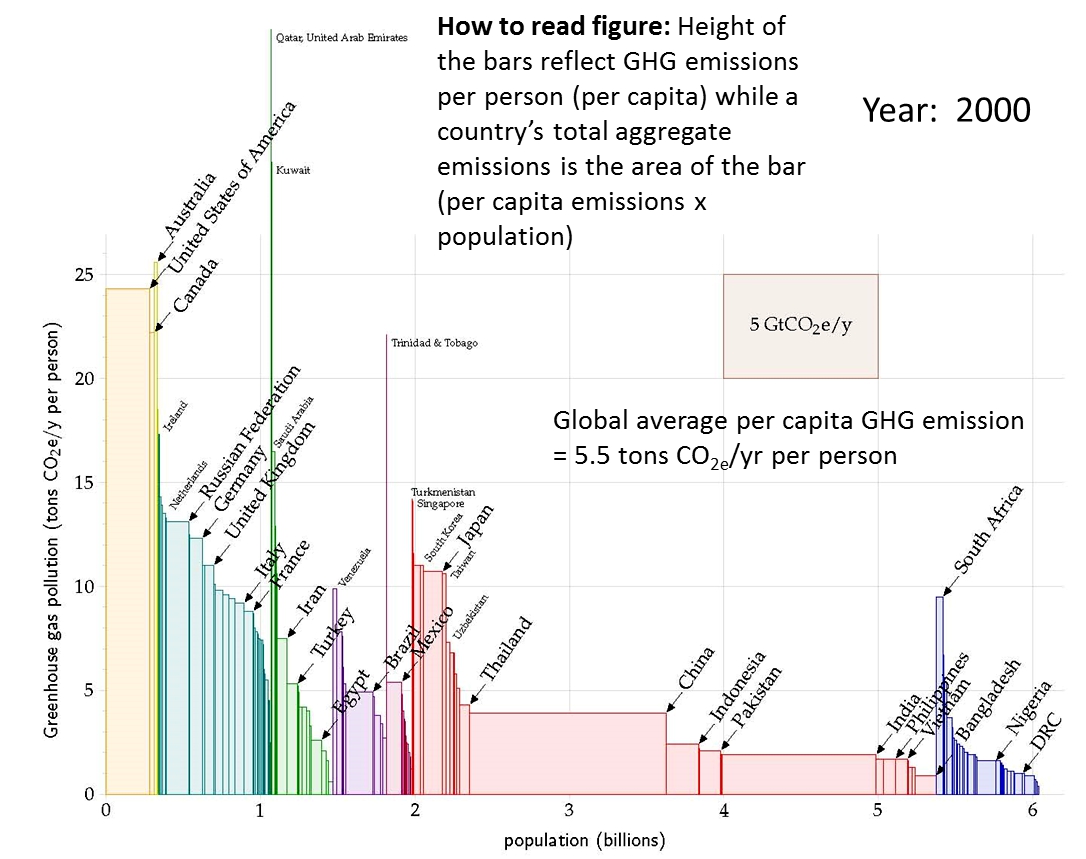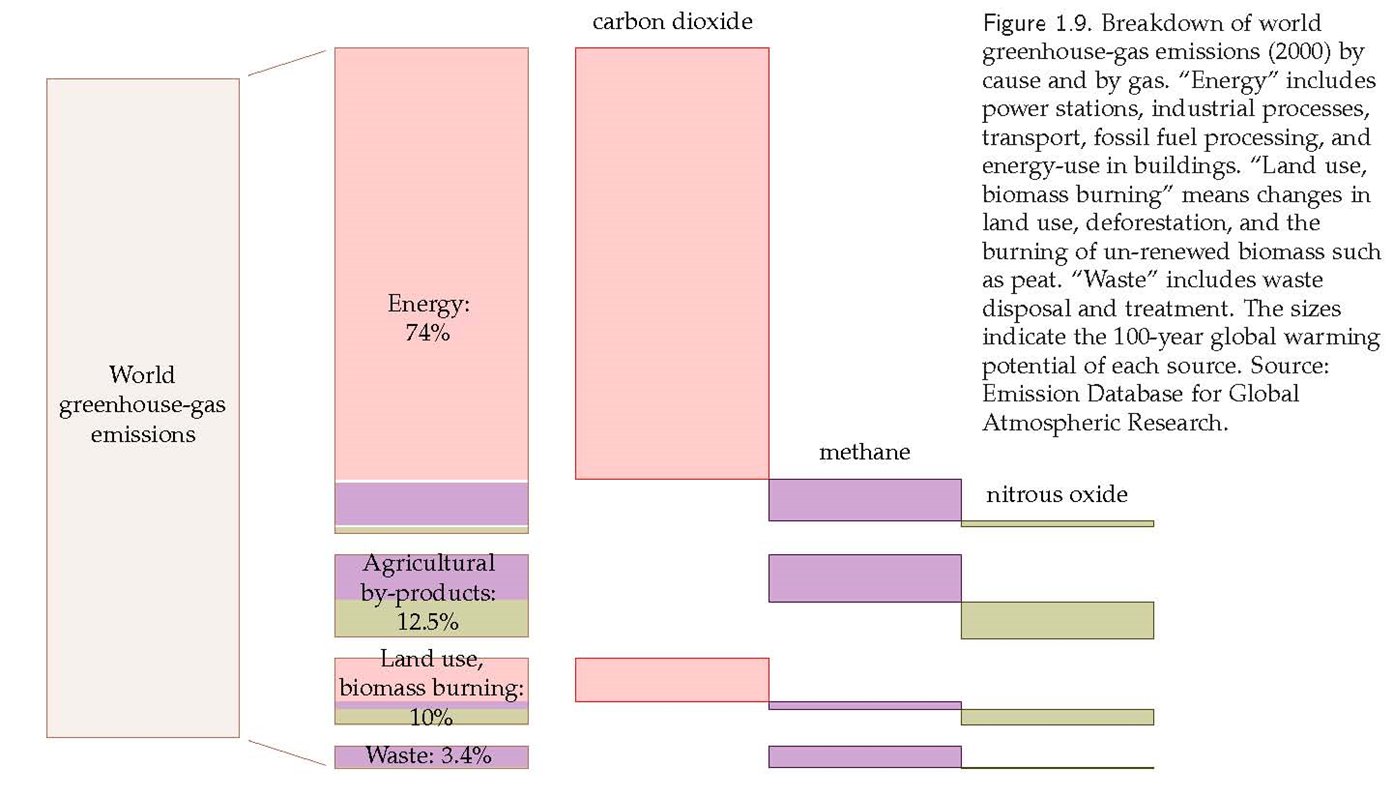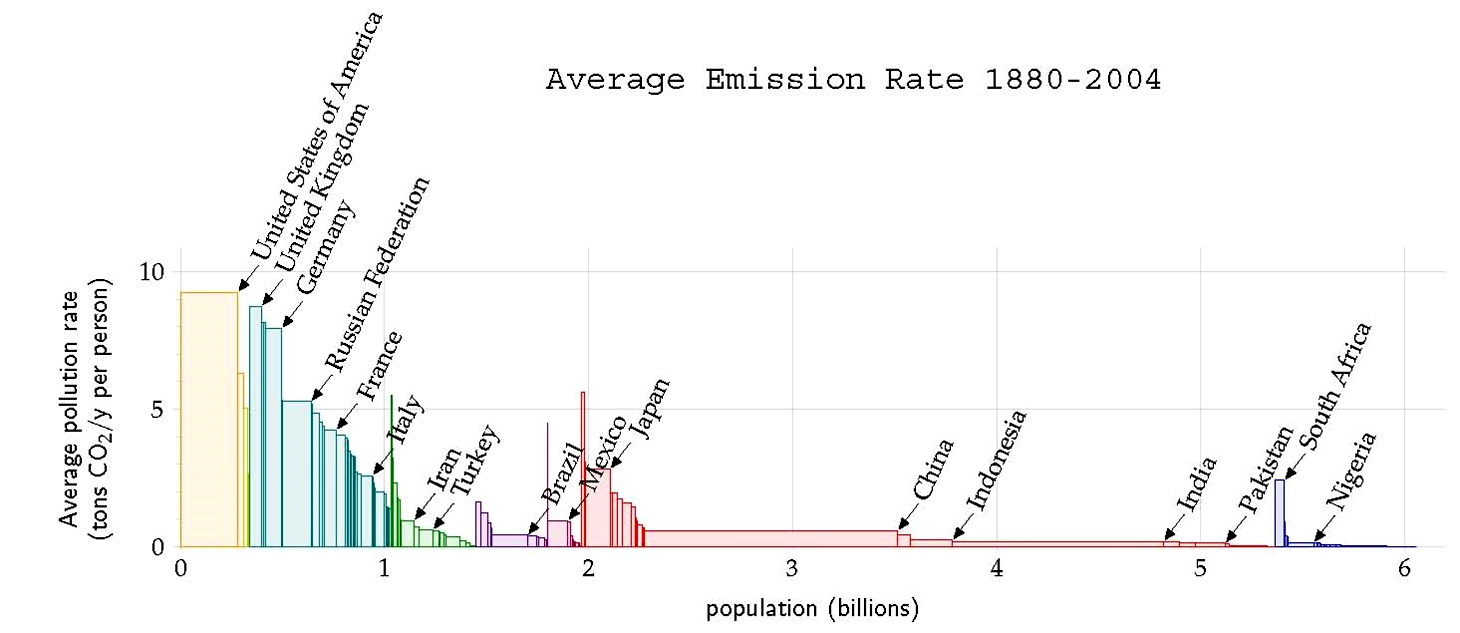Geography/Environmental Studies 339
Debating Greenhouse Gas Emission Responsibilities
Learning Objectives
By the end of this chapter, you should be able to describe:
- The general distribution of greenhouse gas (GHG) emissions around the world;
- Arguments about the ethical responsibilities of different countries to reduce their GHG emissions; and
- The strengths and weaknesses of different metrics to measure GHG emission responsibility among countries that could be used as a basis for international agreements.
To reduce the extent of climate change, the release of greenhouse gases (GHG) must be reduced. To do so, there is a need to develop agreements, policies or rules that lead to such reductions. These in turn require measurement of the responsibilities for greenhouse emissions within and between countries. In this chapter, you will learn about the different ways in which the responsibility for greenhouse gas emissions can be measured. While going through this material, you should be thinking about what you feel would be a fair and effective accounting system for reducing GHG emissions.
Measurement of the warming effect of different greenhouse gases

Any agreement must account for the warming effect of different GHG emissions. While carbon dioxide is the most prevalent greenhouse gas, other gases also absorb heat including methane, water vapor, ozone, and nitrous oxides. The molecules of these gases have different capacities to absorb heat. In addition, they remain in the atmosphere, on average, for different time periods. To estimate the relative global warming potential of a given gas emission one must account for both its different heat absorbing capacities and how long on average the gas molecules remain in the atmosphere after being released. For GHG accounting, the releases of other greenhouse gases are translated into CO2equiv which typically accounts for the gas’s absorptive capacity and removal from the atmosphere generally estimated over 100 years.[1] It is important to recognize that when we refer to CO2equiv in this and other chapters, the greenhouse warming effect of the release of all GHG gases is captured. The warming potential of gases are thus most often expressed relative to carbon dioxide.
| Gas | Greenhouse Gas Warming Potential (over 100-year period)* |
| Carbon dioxide | 1 |
| Methane | 28-36 |
| Nitrous oxide | 265-298 |
*Please note that ranges reflect differences in how warming potential is estimated. See EPA website for explanation.
Different human activities lead to the release of greenhouse gases
As you are aware, different human activities result in the net release of greenhouse gases. These activities include fossil fuel combustion (to produce electricity, move cars, and heat homes); the net removal of vegetation, particularly forests (deforestation); declines in the carbon content in soils; and the release of methane through livestock production, rice cultivation, and from landfills.


As shown in the figure below, global greenhouse gas emissions are produced by the burning of fossil fuels (75%) with agriculture (livestock and rice), land uses (net deforestation and burning), and waste (methane produced in landfills) accounting for the rest.
Ethics and politics of greenhouse gas emission accounting
Responsibilities to reduce greenhouse gas emissions require an accounting of the emissions by countries (for international agreements) and by individuals/companies (within countries). Is such an accounting a first step in assigning responsibilities to reduce GHG emissions? Should the assignment vary depending on the type of emissions or capacity to reduce emissions? Let’s look at each case.
Type of emissions
In thinking about responsibilities to reduce greenhouse gases, should a molecule of a certain greenhouse gas be counted the same no matter how it was produced? More specifically, should greenhouse gas emissions produced by certain human activities be counted differently than from other activities? Even more specifically, should the gases produced by the subsistence activities of the world’s poor be treated the same as those produced by what have been called the “luxury” emissions of the world’s rich? In other words, to what extent should we distinguish between:
Emissions associated with the high levels of consumption of relatively few people, such as those by the United States
FROM
Emissions associated with the subsistence activities of the world’s poor, such as herders raising livestock, those dependent on landfills, farmers growing rice, and those clearing forest for small fields.
Capacity to reduce emissions
 Reducing greenhouse gas emissions requires economic resources, technical sophistication, and institutional capacity. In many ways, industrial countries, contributing a significant fraction of the world’s greenhouse gas emissions, have the most capacity to reduce emissions. Their capacity stems in large part to the their economic development which was driven by cheap fossil fuels. Therefore, it could be argued that they should be expected to reduce more than developing countries.
Reducing greenhouse gas emissions requires economic resources, technical sophistication, and institutional capacity. In many ways, industrial countries, contributing a significant fraction of the world’s greenhouse gas emissions, have the most capacity to reduce emissions. Their capacity stems in large part to the their economic development which was driven by cheap fossil fuels. Therefore, it could be argued that they should be expected to reduce more than developing countries.
How should reduction targets be determined?
Any agreement, whether binding or voluntary, requires reduction targets. Should an international agreement simply state that all countries should reduce their GHG emissions by the same absolute amount (X tons of CO2 equiv per year) or should there be a percentage reduction? This has huge implications. If a percentage reduction would be required, larger emitters be required to reduce more than lower emitting countries. Given the huge imbalance of emissions among countries, a percentage reduction is the only method that has been considered[2] in international negotiations.
Let’s consider the implications of these different accounting metrics
Consider the implications of basing emission reduction targets in relation to aggregate national emissions or the national average emission rate per person.

The area of the rectangles in this graph represent the aggregate national emissions of countries around the world in 2000. The height of the rectangles in this graph represent average per capita emissions of countries around the world in 2000.
These ethical and institutional challenges are what the international community has faced and continues to face when working toward agreements to reduce global greenhouse gas emissions. In preparation for class, think through these dilemmas while imagining yourself as a climate agreement negotiator for different countries.
- The choice of 100 years is somewhat arbitrary and we must be aware that a given quantity of a greenhouse gas will represent a larger number of CO2equiv if evaluated over a shorter time period if that gas tends to leave the atmosphere more quickly than CO2. ↵
- Even if one was not interested in equity considerations, an absolute reduction is not practical since it could lead to mandated annual reductions exceeding what a country emits during a year. ↵
In the digestive tracts of ruminants, anaerobic conditions (no oxygen) predominate and therefore a portion of organic matter consumed by ruminants in the form of methane, an important greenhouse gas.
Rice cultivation requires the flooding of land which causes the organic material in and on soils to decompose under anaerobic conditions resulting in releases in methane, an important greenhouse gas.


